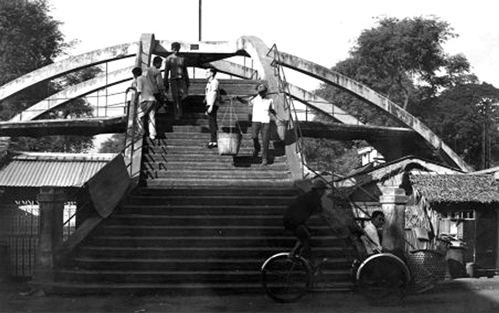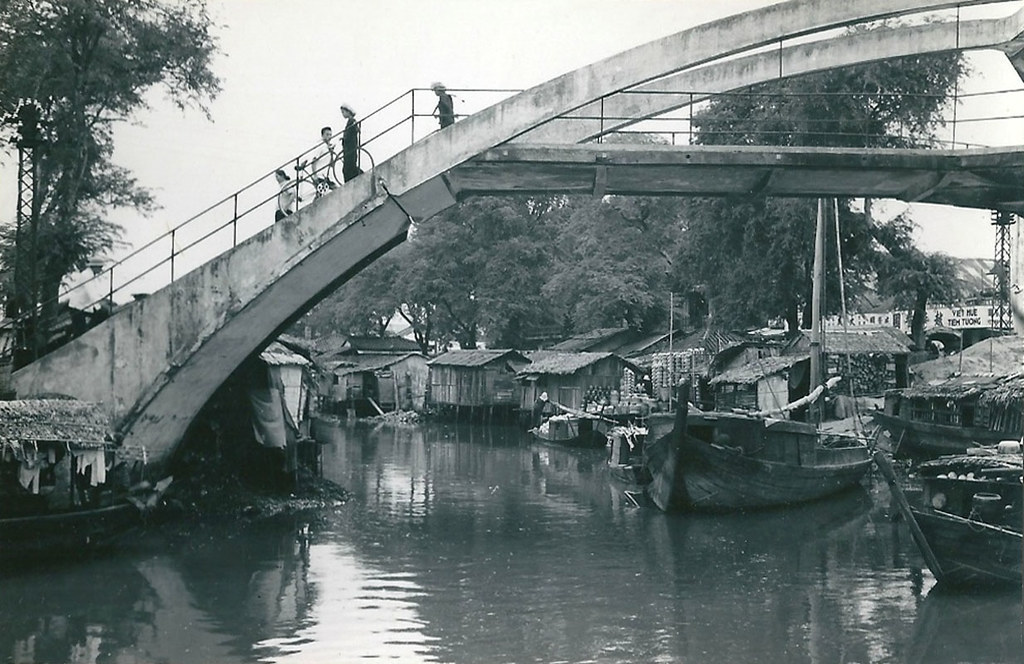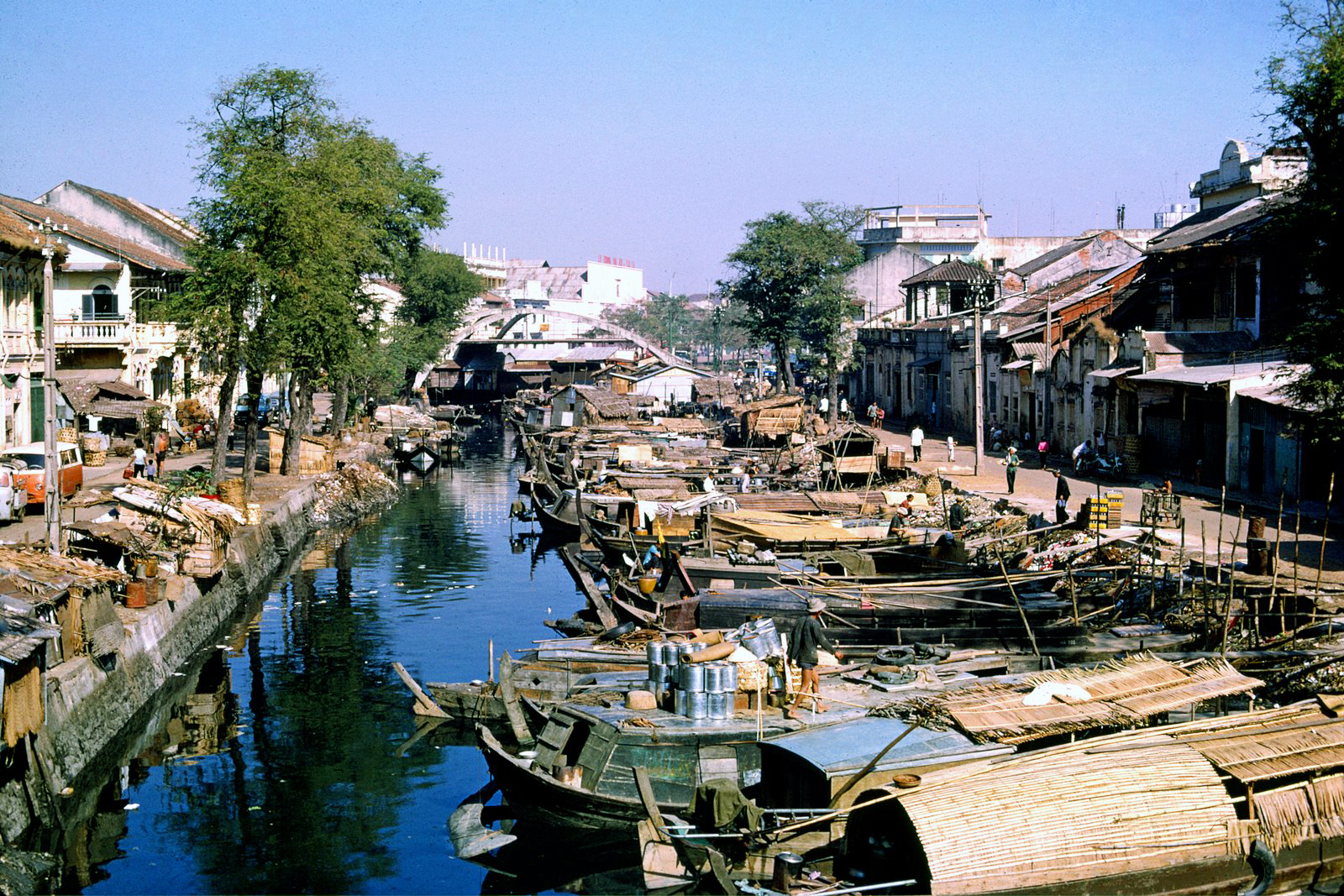Interesting revelation about Ba Can Bridge – The first pedestrian bridge in Saigon
Cầu Ba Cẳng, with its peculiar shape, is closely associated with stories of the pre-1975 Saigon River.
The bridge was constructed by the French, featuring three arches and being intertwined with a part of the history of the old Chợ Lớn area.
Cầu Ba Cẳng is situated at the corner of Bãi Sậy Street (formerly a branch of the Hàng Bàng canal, District 6) and Vạn Tượng Street, right at the turning point towards the Tàu Hủ canal. Its two ends rest at Bãi Sậy pier and Nguyễn Văn Thành pier, while the other end is located at Vạn Tượng pier. The bridge dates back to the French colonial period but was demolished in 1990 due to collapse.
Ba Cang Bridge crosses 3 different directions. Photo: Flickr
Cầu Ba Cẳng, known as Pont des 3 arches in French, was built by the Brossard et Mopin company (the same company that constructed the Bến Thành Market in 1914). Previously, the bridge had various names such as Khâm Sai – named after the French engineers who built it, or Ba Miệng Bridge and Ba Chưng Bridge (Three Legs Bridge). However, over time, people stopped using the original name and started referring to it as Ba Cẳng Bridge due to its distinctive design.
According to Trương Đạm Thủy, a local writer, "In the district of Chợ Lớn, there was a peculiar iron bridge with three legs about several decades ago. Since the bridge did not have an official name like Bông Bridge, Kiệu Bridge, Nhị Thiên Đường Bridge, Tân Thuận Bridge, the locals named it based on its appearance, which was Ba Cẳng Bridge."
True to its name, Ba Cẳng Bridge has three legs, which also serve as stairways made of reinforced concrete exclusively for pedestrians. The bridge was designed with three legs in three directions due to its location at the confluence of waterways. It features a single span arch, creating a space for boats to pass through, facilitating the transportation of residents on both sides of the river. This area was also a bustling waterway trade route in the old Chợ Lớn area.
Ba Cẳng Bridge has never been a significant transportation route in the Chợ Lớn area, but it holds a special place in the hearts of local residents. It provided a short and convenient pedestrian route to the Kim Biên market (District 5) and served as a gathering place for neighbors to relax, chat, and enjoy the breeze. Its role was similar to the current pedestrian bridges across the Tàu Hủ canal. Cyclists had to carry their bikes on their shoulders and walk to cross the river.

The way to Ba Cang Bridge in the past. Photo: Flickr
Ba Cẳng Bridge has become a part of the history of old Saigon – Chợ Lớn. It is associated with the nickname "dân chơi cầu Ba Cẳng" (the Ba Cẳng bridge enthusiasts) that was popular before 1975, and it has been passed down to this day, reminiscing about a group of "daring and bold" individuals.
The ԍιᴀɴԍ нồ gang originated in this area, led by Mã Ban. He was skilled in martial arts, of Chinese descent, and had been an orphan since childhood. Thanks to his physical strength and martial arts skills, Mã Ban eliminated other gangs and became the protector of Chinese-owned restaurants and eateries.
Due to his righteous and reputable actions, Mã Ban was rewarded by a wealthy Chinese entrepreneur, who arranged his marriage with his daughter, leading to a prosperous life for Mã Ban.
During gatherings and socializing with friends, Mã Ban was known for his generosity, lack of calculation, and willingness to sacrifice for others. His extravagant lifestyle as a gang leader was also portrayed in Trương Đạm Thủy's stories.
Please review the pictures of Ba Can Bridge - Saigon's first pedestrian bridge:

Bicyclists have to carry their bikes onto the bridge. Saigon 1950

Source: Internet
In the distance are Ba Cang Bridge and the building of TRUONG VAN DONG soap company on Kim Bien street. On the left is the Gia Phu-Ben Kim Bien junction, on the right is Van Tuong Wharf.
Follow Sai Gon on motorbike tour to discover every corner of Ho Chi Minh city.
Ngoc Nguyen